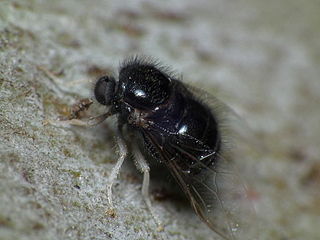
The Nematocera are a suborder of elongated flies with thin, segmented antennae and mostly aquatic larvae. This group is paraphyletic and contains all flies except for species from suborder Brachycera, which includes more commonly known species such as the housefly or the common fruit fly. The equivalent clade to Nematocera is the whole Diptera, with Brachycera as a subclade. Families in Nematocera include mosquitoes, crane flies, gnats, black flies, and multiple families commonly known as midges. The Nematocera typically have fairly long, fine, finely-jointed antennae. In many species, such as most mosquitoes, the female antennae are more or less threadlike, but the males have spectacularly plumose antennae.

The Mydidae, or Mydas flies, are a cosmopolitan family of flies. It is a small family, with about 471 species described. They are generally large in size, including the largest known fly, Gauromydas heros. Many of the species, in addition to their large size, are mimics of stinging hymenopterans, especially wasps.

Tachytrechus is a genus of long-legged flies in the family Dolichopodidae.

Ferdinandea is a genus of syrphid flies or hoverflies in the family Syrphidae. There are about 16 described species in Ferdinandea.

The Milesiini is a large and diverse tribe of hoverflies. They mimic wasps or hornets.

Philopotinae is a subfamily of small-headed flies. They have an arched body shape, as well as enlarged postpronotal lobes that form a collar behind the head. Their larvae are endoparasites of araneomorph spiders in the subgroup Entelegynae.

Panopinae is a subfamily of small-headed flies (Acroceridae). Their larvae are endoparasites of spiders in the infraorder Mygalomorphae.

Acrocera is a genus of small-headed flies in the family Acroceridae.

Ogcodes is a cosmopolitan genus of small-headed flies in the family Acroceridae. About 90 species have been described for the genus. It is the most common and speciose genus in its family. These flies are endoparasitoids of ground-dwelling entelegyne spiders.

Pterodontia is a genus of small-headed flies. There are at least 20 described species in Pterodontia.
Ocnaea is a genus of small-headed flies. There are 20 described species in Ocnaea.
Carvalhoa is a genus of small-headed flies in the family Acroceridae. The genus is endemic to Chile. It was originally known as Sphaerops, named by Rodolfo Amando Philippi in 1865. This name was found to be preoccupied by the reptile genus Sphaerops Gray, 1845, so it was renamed to Carvalhoa by Ahmet Ömer Koçak and Muhabbet Kemal in 2013. The genus is named after the Brazilian dipterist Claudio José Barros de Carvalho.

Apsona is a genus of small-headed flies. It contains only one species, Apsona muscaria, which is endemic to New Zealand. It is very similar to the North American species Eulonchus smaragdinus.
Exetasis is a genus of small-headed flies. It is known from Brazil and Argentina.
Megalybus is a genus of small-headed flies in the family Acroceridae. It contains three species found in Chile, though two species have also been reported from Neuquén Province of Argentina.
Arrhynchus is a genus of small-headed flies in the family Acroceridae. It was formerly considered a synonym of Ocnaea, but was reinstated as a valid genus by Schlinger in 1968. It is endemic to Chile.
Holops is a genus of small-headed flies in the family Acroceridae. It is endemic to Chile.

Lasia corvina is a species of fly from the genus Lasia in the family Acroceridae. The species was originally described by Wilhelm Ferdinand Erichson in 1840. It is recorded from Chile and Argentina.












